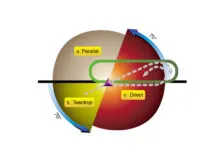Regulations often have some statutory morasses that defeat common sense. Yet, sometimes, there’s a blow for the common man and reason wins out—at least partially.
This Plus That
Take the ILS Z Rwy 24 approach into Wilmington, NC (KILM). It’s a hybrid of two other approaches: the ILS or LOC Y Rwy 24 and the RNAV (GPS) Rwy 24. It was requested because the original ILS’s only IAF is the LOM/FAF and has a mandatory procedure turn.
The asterisk by Wilmington Approach’s name in the frequencies line tells us it’s only part-time—no vectors to final after hours; you had to fly the course reversal.
The RNAV (GPS) approach makes this a non-issue for pilots with GPS. This approach uses the Terminal Arrival Area (TAA) concept centered on TOPSY. Any arrival on a bearing to TOPSY from 326 degrees counterclockwise to 145 degrees simply crosses TOPSY at 2000 feet and continues inbound. In most of that area they can descend to 2000 feet 30 miles out, with a small segment over the Atlantic at 2100 feet. Can’t be terrain out there; must be airspace.
Approaches from the other side of the arc avoid the procedure turn by flying direct to IZIMU or JERNI, then TOPSY at 2000 to proceed inbound.
With WAAS, they can fly an LPV glidepath to the same minimums as the ILS Y: a DA of 200 feet and 1/2 mile vis. Without WAAS, however, you’re stuck with 500 feet for an MDA. So without WAAS, you can either avoid the procedure turn via the GPS approach, or get a DA of 200 feet on the ILS, but not both.
The GPS glidepath and ILS glideslope are both three-degrees, crossing the threshold at 47 feet. The ILS FAF is only eight feet lower than the GPS and ILS Y FAF, SUMLY. That puts it just 160 feet closer to the airport.
Suffice it to say the approaches are the same. So, the thinking went, what about using the RNAV TAA, which does not require WAAS, but intercepting the localizer and then flying the ILS? Enter the ILS Z approach.
“But, wait,” you say, “what about the Z as a loc-only or circling? Wassup?”
Hold that thought. You might not need to circle anyway because KILM has ILSes to Runways 35 and 6 as well. Those ILS Y approaches have the same vectoring issues, but they have Z versions with the same solution, so it’s all good.
“Okay, but why is there no circling option for the Z version?”
Special Notes
Why would you want to circle when this approach has the exciting note: “RVR 1800 authorized with use of FD or AP or HUD to DA.” That might sound like airline-only stuff, but it’s not. Fly this ILS fully coupled to an autopilot with glideslope, or follow a flight director, (or have a HUD, not including the “HUD” view on your iPad) and you can land from DA with as little as just 1800 RVR.
“Cool, but the circling—”
Another unusual note is “ASR” right under the non-standard alternate minimums. This stands for “Airport Surveillance Radar,” and means radar minimums are published for this approach. You find these in the old style green approach books or as Radar Minimums in your favorite app or website.
Flying an ASR is worthy of its own article, but in a nutshell it means a controller vectors you all the way down final, issuing more detailed instructions like, “Eight miles from touchdown, slightly right of course. Turn left heading 240. Recommend altitude 1800.” If you’re perfect the controller lets you know he’s still there with simply, “Three miles to touchdown. On course.”
You’re told when to begin descent to MDA and when you’re at the missed approach. You can fly this non-precision approach with nothing but a transponder and a radio—which could be handy if your navigator ever takes a holiday.
Last Laugh
“That’s all great, but all the Z approaches show straight-in minimums only.”
Why would you need to circle? Instead, just fly the ILS with vectors, or the RNAV, which only needs an IFR GPS?
“But why not publish them? At least you’d have the option of changing your mind and circling off the ILS approach.”
Um, well, yes. That’s a fair point.
After some research it seems the reason is… when they requested the hybrid, no one checked the boxes to request the localizer-only and circling minimums.
It simply lacked the paperwork.
Jeff Van West occasionally lets a good monster movie distract him from the proper paperwork.




